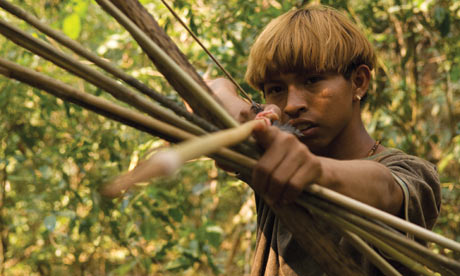The cast had never acted and scripts were impossible, but Chilean director Marco Bechis still managed to make his film about obscure Brazilian Indians. Tom Phillips finds out how
By Tom Phillips
Instead, acting on the advice of members of indigenous rights group Survival International, whom he had met in Milan, Bechis travelled to the Brazilian state of Mato Grosso do Sul. There he found Vilhava and the Guaraní-Kaiowá people struggling to regain their land, thousands of miles south of the world's largest tropical rainforest. "When I met the Kaiowá just dressed in normal clothes, drinking alcohol and using mobile phones–even if they were never charged up because they don't have electricity–I said: 'This is what Indians are today. This is the film.'"
Shot over 10 weeks in 2007, Birdwatchers focuses on a group of Guaraní-Kaiowá as they attempt to reclaim their land from a local farmer, in what is known in Portuguese as a retomada or "retaking." While the wealthy cattle rancher kicks back on his idyllic country estate, showing European birdwatchers slides of the local wildlife, the Guaraní-Kaiowá eke out a precarious existence, slaving away on sugar cane plantations and living in a shabby squatter settlement.
Then there's this tidbit:
For more on the subject, see The Best Indian Movies.
Below: "Ademilson Concianza Verga as Irineu in Birdwatchers."


4 comments:
Rob,
Twilight has nothing to do with being real or even realistic. Not that the producers shouldn't have cast appropriately, but having a Native actor on Twilight say to the director "That's not how we really turn into werewloves" makes authenticity a mute point.
So here's my rant today: When are we going to stop seeing Natives as loin cloth or headdress-wearing savages losing to, or being saved by the white man? ENOUGH!
I have seen to many docu-dramas and too many PBS specials about the HISTORY! Then Hollywood comes along and remakes THE LONE RANGER!
Even Windtalkers...Beach is Saved by loser Cage...HURRAY!
I know the Native community understands itself. I know they know their own history. So why do we keep showing the general population these images of "savages" or nomadic wanderers that can't put two words together over and over without balancing that with contemporary, positive, uplifting, visions of hope, success, and a place in modern society...which they have. I know way too many tribes who are making their own path, and Native Americans that successfully "walk both paths" yet that's something we rarely if ever, get to see.
Keep the faith,
Jet
"Thanks for succinctly stating the benefit of using indigenous actors. Twilight producers, take note."
Well, there are some probably Indian "Amazonian Vampire" characters that have a minor role toward the end.
Perhaps they could cast the same people in the roles.
Native actors, especially Quileute actors, might've noticed a dozen little details that were wrong. Not in the werewolf phase, obviously, but in the rest of the movie(s).
Twilight wants to convince us the movies are taking place in Forks and La Push, Washington, near the Quileute reservation. And not in Vancouver, Oregon, or a set in Los Angeles. Therefore, realism is not a moot (not "mute") point.
Rob, sorry for the typos,
You make my point for me. Yes, I too would like to see a nod towards more "realisim" but the fact is the indians in Twighlight are there for one reason: to be werewolves. That is the only thing that serves the story. The thought never crossed the writers, directors of producers mind that "Hey we have a chance here to educate a lot of people about real indians."
In fact you could even assume that the producers would try to stay closer to stereotypres as to "not confuse" the viewing public.
I would bet that 90% of the non-indian population has not a vague idea about the diversity among the tribes and bands of North America.
Keep the faith,
Jet
Post a Comment